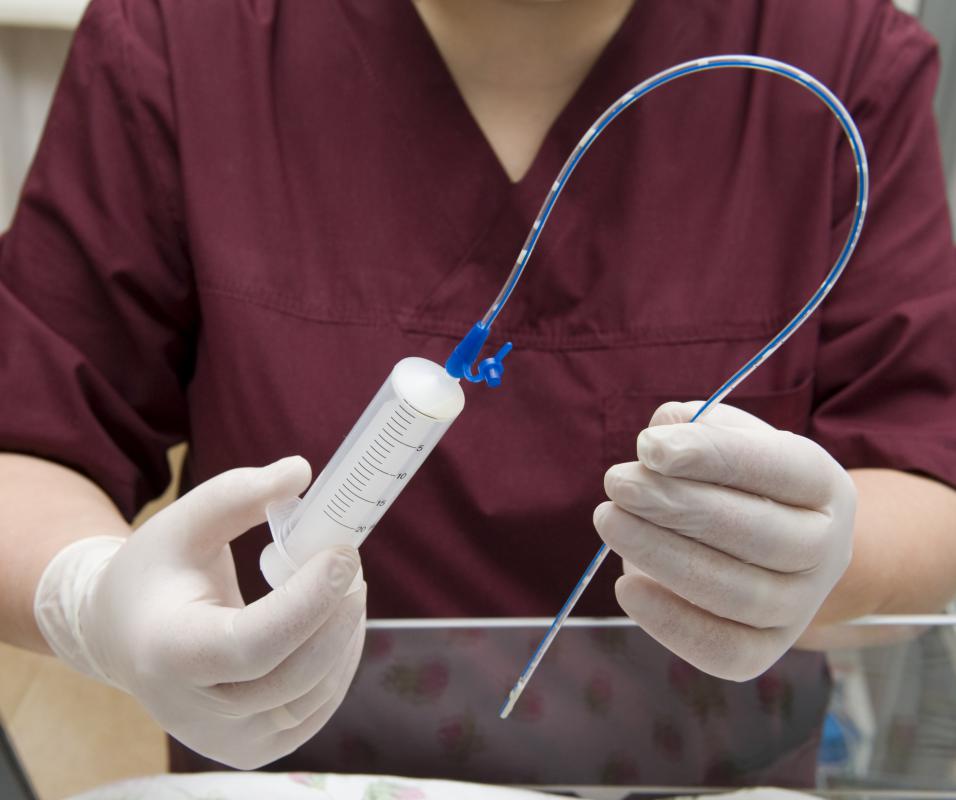At TheHealthBoard, we're committed to delivering accurate, trustworthy information. Our expert-authored content is rigorously fact-checked and sourced from credible authorities. Discover how we uphold the highest standards in providing you with reliable knowledge.
What is a Nasogastric Tube?
The nasogastric tube, which is also called an NG tube, has numerous applications in medicine. It can be used in hospital settings or it may be employed in home care settings. In the latter it is frequently employed for feedings, especially when a person or infant/child may have challenges eating by mouth. Thus health care workers and people specializing in home care, including parents and medical laypeople, may need to learn how to insert this flexible plastic tube.
There can be different widths or lengths in which the nasogastric tube comes. As suggested by the name, the tube is inserted into one of the nostrils. It then must be carefully threaded down the back of the throat until reaching the stomach, via the esophagus. It can take a little skill to learn how to do this, but once learned most people become quite gifted at inserting one. Since the nasogastric tube is often left in place for a defined period, people must also learn to securely tape the tube to the face so that it won’t come out or proceed farther into the stomach.

In medicine there are multiple uses for the nasogastric tube. Liquid food or medicine may be inserted into it. Certain liquids/medicines that are commonly used in an NG tube include activated charcoal, which may be inserted via nasal passage to treat cases of poisoning or overdose. NG tube feeding is not just for people who can’t eat via normal means, but also may be employed for people refusing to eat, such as those with conditions like anorexia or bulimia.

As much as people may view the nasogastric tube as a means of inserting things into the stomach, it has other purposes. It can also be employed to drain liquids from the gastrointestinal tract. After certain abdominal surgeries people may have a gastric fluid drain in the form of an NG tube.
Many view use of the nasogastric tube as an extreme medical intervention. It does look very severe, protruding from the nose. In most cases, people who must routinely use an NG tube get used to it quickly.

Tubes may provide the perfect solution for infants or children with failure to thrive issues. That doesn’t mean NG tube use is completely without discomfort, and some people have sore noses, nosebleeds, or get infections if the tube is not changed as directed, or a few people will suffer damage to the nasal structure. Many others don’t have this problem.

For anyone planning to use an NG tube at home, and this includes many parents, it’s very important to get medical instruction. This is often done in the hospital setting, and parents should feel free to ask for more demonstrations, training, or watching of tube insertion, so that they understand fully and can perform insertion easily, prior to leaving the hospital. Since many children may depend on tube feedings and parents inserting tubes, it is important that parents feel comfortable with this procedure before they bring babies or children.

When the nasogastric tube is not an acceptable treatment there are other alternatives. Small surgeries like gastronomies may create pathways to the stomach when long term feeding that is not oral is needed. For some people, this easier access is a better choice.
AS FEATURED ON:
AS FEATURED ON:
















Discussion Comments
It's hard when you see a child with an NG tube. It always makes their case seem less hopeful than perhaps it really is. I completely understand why they are commonly used, though.
Sometimes, they're used to pump a stomach, too. My cousin's ex boyfriend drank too much at a fraternity party (imagine that!) and was well on his way to alcohol poisoning when she got him to the ER. They couldn't get him roused enough to insert a tube down his throat, so they had to go with an NG tube to pump his stomach and get as much of the alcohol out as they could. It was a near thing. He was a little blue around the fingertips and lips when she got him to the hospital, and the doctor said another 15 minutes and he would have been gone.
A friend's son has leukemia and developed pancreatitis. He had to have a nasogastric tube for a few days because he couldn't keep anything down, and the NG tube helped because he was receiving nutrients through it. He didn't like it and would hardly talk with it in, but he fought through it like the little lion he is and he is much better now.
Thank the Lord, he is responding very well to treatment. His doctor thinks the pancreatitis was probably caused by the radiation treatments he had, as well as the chemotherapy. The young man is only 8, but he's a real fighter.
Post your comments